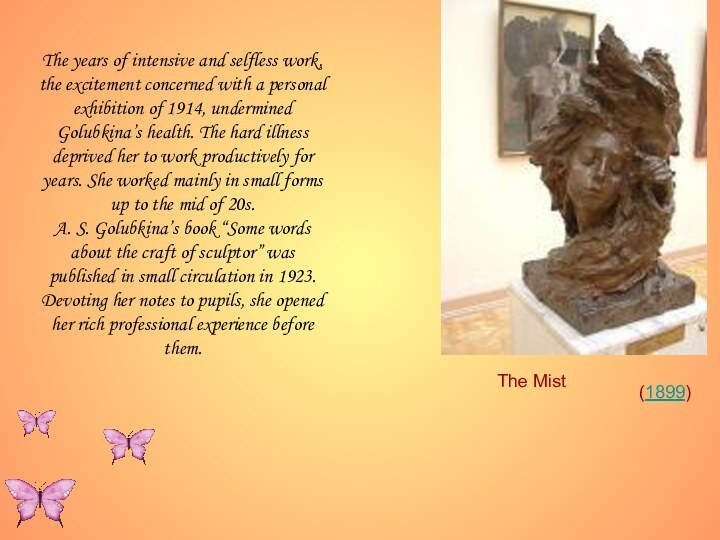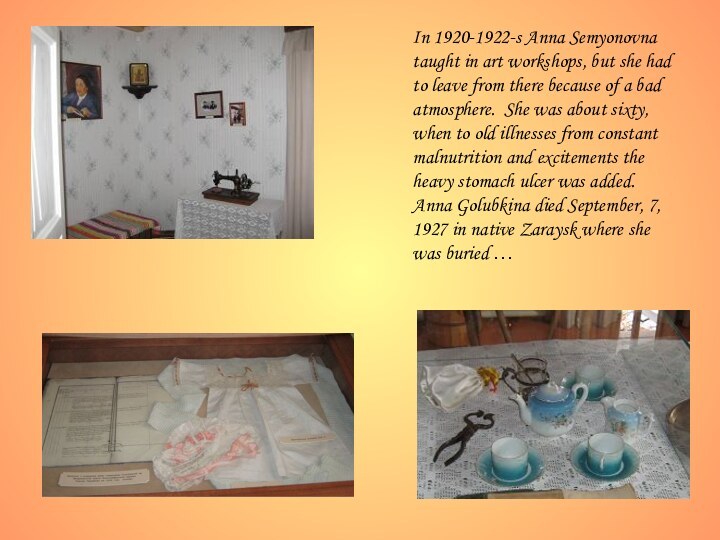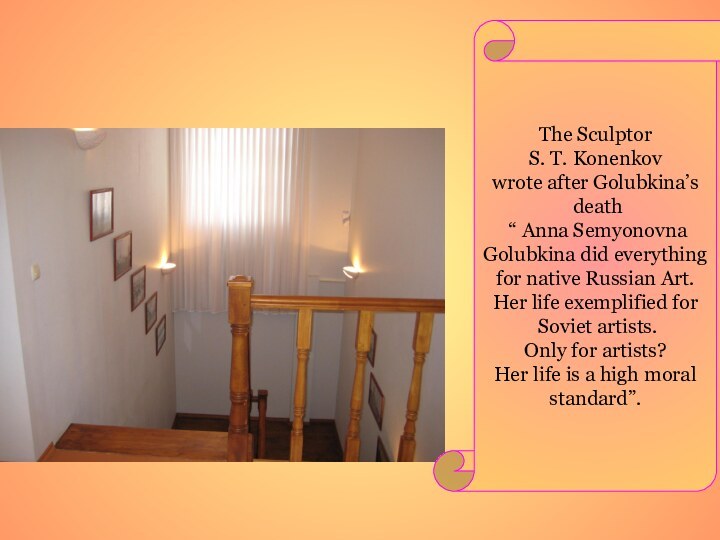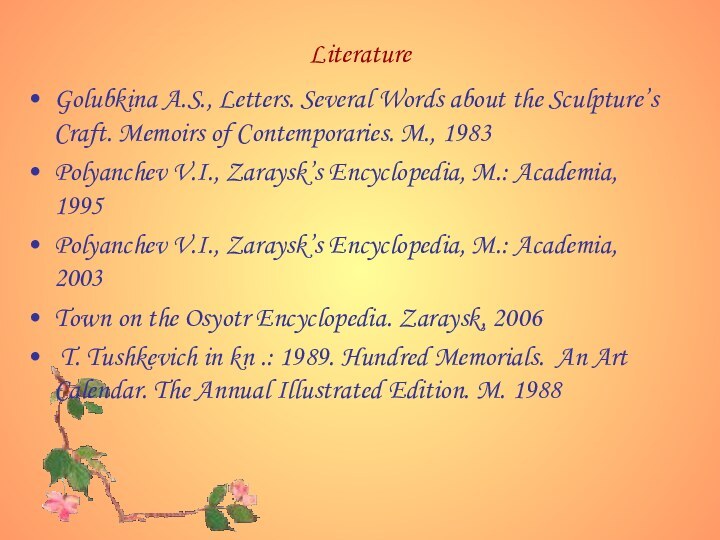Слайд 2
The plan
Introduction
Chapter 1. Anna Semyonovna Golubkina’s Life
1.1 The Reflection of Master’s Soul in Works
1.2
The Family and the Childhood of the Sculptor
1.3 Learning and the Next Years of Sculptor’s Life
Conclusion
Literature
Слайд 3
Introduction
Anna Semyonovna Golubkina (1864-1927) was born and grew
up in Zaraysk, in the family where some generations
were engaged in market-gardening. On a cast of character Golubkina was a courageous, strong-willed and disinterested person of firm vital belief, sensitively responded on sufferings and injustice. She was endlessly kind, and her kindness always brought effective help.
There is still to present day the museum of A.S. Golubkina in Zaraysk. Life and work of the outstanding sculptor is interesting, and attracts tourists.
Слайд 4
The purpose of research consisted in studying the

sculptor’s life and work.
Object of research: books,
encyclopedias, visiting of a museum.
Subject of research: A.S. Golubkina's Works.
Research problems:
1) To get acquainted with A. S. Golubkina’s creativity;
2) To find out, what influenced on Anna Semyonovna’s choice of trade in her childhood;
3) To define the basic events in sculptor’s life.
Methodological basis of research. The achievement of the research purpose and the solution of tasks stipulate the necessity of use of a complex of general scientific theoretical (the theoretical analysis, a certain definition, modeling) and empirical (studying of the special literature, dictionaries) methods of research.
Structure of work: research work consists of introduction, one chapter, conclusion, bibliography and multimedia presentation.
In introduction the urgency of the research theme, its theoretical and practical importance is proved, the object, a subject, the purpose and research tasks are defined.
The first chapter of scientific work « Life and Works of Anna Semyonovna Golubkina » is devoted to the history of her life and the basic works of sculptor are investigated.
In conclusion the totals of research are summed up and brief conclusions are formulated.
Слайд 5
Anna Semyonovna Golubkina’s Life
1.1 The Reflection of Master’s
Soul in Works
A.S., being exacting to herself person, always
persistently aspired to achieve vital expressiveness in her works. The essential principle of art for her was pleasure of work, high applicability of the artist, deep comprehension of nature. Meanwhile in formation of Golubkina’s creative and human aspect her origin, way of life, milieu had an extreme significance. Not only in childhood, but all her life.
Her student's sculptures were admitted as the best ones for many times and were distinguished from works of other pupils.
Слайд 6
A. S. Golubkina began her art way towards

the end of the last century. The aggravated sensation
of the leaving old world, the presentiment of the future terrible events was typical for many artists’ attitude. Golubkina introduced the theme of waking up people easily. "The Iron One" (1897), " The Worker" (1900), " The Slave" (1909) are remarkable for the big force of expressiveness. The sculpture «The Going Man" (1903) is especially significant. The resolute step of represented one opens the emotional substance of the movement motive, reproduces the will to struggle. Allegorical meaning of a plastic image is also peculiar to the well-known relief «The Wave" (1902) which decorates the facadeA. S. Golubkina began her art way towards the end of the last century. The aggravated sensation of the leaving old world, the presentiment of the future terrible events was typical for many artists’ attitude. Golubkina introduced the theme of waking up people easily. "The Iron One" (1897), " The Worker" (1900), " The Slave" (1909) are remarkable for the big force of expressiveness. The sculpture «The Going Man" (1903) is especially significant. The resolute step of represented one opens the emotional substance of the movement motive, reproduces the will to struggle. Allegorical meaning of a plastic image is also peculiar to the well-known relief «The Wave" (1902) which decorates the facade of Moscow Art Theatre. The Struggle of person and elements personifies embodies mutinous spirit of epoch.
"The Iron One" (1897)
«The Going Man“
(1903)
Слайд 7
It fell to Golubkina’s lot to be the
witness and the participant of big social shocks. She
was closely connected to revolutionary movement. Under the order of Moscow committee RSDRP, in 1905 Golubkina created K. Marks portrait.
Golubkina took an active part in human destinies, she organized artel of the dismissed from factory shoemakers, arranged theatre for Zaraysk’s workers.
The sincere sympathy for person, the interest to his internal life determines the main feature of Golubkina creative works. The portrait genre takes the central place in her heritage. In any model, whether it be a simple person from people or a deeply intellectual creative person, she always reveals spiritual essence, emphasizes the force of human spirit. The hope and belief are expressed by "The Person" (1910). Golubkina lifts an image above daily occurrence, reveals the most essential in the person.
Слайд 8
The Old Age” (1898)
Golubkina had the sense of
a material - marble, tree, clay, their expressive opportunities,
decorative qualities. But the most favourite material was the clay which obediently reproduced easy touch of fingers, allowing working quickly, and keeping freshness of nature impression. In the complete work the process of work over the material is traced, opening the becoming of an artistic image from its amorphous mass. This effect is mostly expressive in images of the spontaneous vital beginnings - "The Fire" (1900). The two-figured composition "The Fire" is conceived for a fireplace. Rolling up figures of sitting man and woman should be located in the way the trembling light of a flame covered energetic forms, filled the plastic with dramatic emotional force.
Слайд 9
The years of intensive and selfless work, the
excitement concerned with a personal exhibition of 1914, undermined
Golubkina’s health. The hard illness deprived her to work productively for years. She worked mainly in small forms up to the mid of 20s.
A. S. Golubkina’s book “Some words about the craft of sculptor” was published in small circulation in 1923. Devoting her notes to pupils, she opened her rich professional experience before them.
The Mist
(1899)
Слайд 10
Crisis came in 1925. Golubkina worked intensively, with
the big rise. She made portraits of her two
old assistants –a moulder G. I. Savinsky (1925) and a woodcarver I. I. Bednyakov (1926), showing deep respect to the person of work. Two characters, two attitudes are transferred by the sculptor: optimism, joyful acceptance of life and thoughtfulness, depth of experiences .
In 1927 the master worked over the most known works of art- "The Birch" and L. N. Tolstoy's portrait. A fragile figure of girl is a poetic symbol of youth, awakening, and readiness for life. The dress fluttering on a wind fits a harmonious body, creating set of tucks, forming filled with quivering movement silhouette.
"The Birch"
Слайд 11
The charm of this image consisted in the
lyrical statement of beauty spiritualized by an impulse. The
figurative decision of L. N. Tolstoy’s portrait of is given in other intonation. The portrait of great genius amazes with titanic force. The integrity of a nature, strong-willed activity of person is perceived as the supreme display of the creative beginning of the person. The spiritual energy of image is transferred by power of expressive modellings.
"The Birch" and L. N. Tolstoy's bust became the result of a creative work of the big artist - Anna Semyonovna Golubkina.
“L. N. Tolstoy”
Слайд 12
1.2 The Family and the Childhood of the
Sculptor
Anna Semyonovna Golubkina was born in 1864 and
was brought up in Zaraysk in the petty-bourgeois family.
Her grandfather - Polycarp Sidorovich came from serf of the princes Golitsyny that owned big estates in the Ryazan province, but managed to pay off on will and made his home in Zaraysk, engaged in market-gardening. All her childhood and youth Anna worked in the garden together with her mother, brothers and sisters.
All her life she kept respect for physical work, bright and figurative folk speech and self-respect. Polycarp Sidorovich was an original person. Coming from staroverchesky family, he strictly observed old Russian customs and traditions, both religious, and everyday. He replaced Golubkina’s father who died young in 1866 when the future sculpture was only 2 years old.
Anna Semyonovna Golubkina’s grandfather – Polycarp Sidorovich
Слайд 13
In general in Golubkina’s family Christianity was treated

mainly as the moral doctrine. For the senior members
of Golubkina’s family God was not the severe and cruel judge, but the symbol of good and justice. The moral law of Golubkina’s family life was kindness, truth and justice. For example: porridge was cooked in kitchen for passers - by and local beggars every day. A cast-iron pot with porridge was exposed on an external ledge of a window. Who was hungry, took this cast-iron pot, ate porridge, and on the next day the empty cast-iron pot appeared under the window.
One of Golubkina’s friends wrote about her childhood in Zaraysk: “There was a lot of excellent white clay nearby the house, and the future sculptor very early began to make from it statuettes of uncountable four-footed friends - cats, dogs, horses, lived on a coaching inn…. Anna liked to climb up a wide parapet of the Kremlin walls. From here through loopholes immense steppe spaces opened. Many years ago innumerable hordes moved there …. ”.
Слайд 14
The sculpture’s mother Ekaterina Yakovlevna (not Tatarinova) came
from a solvent family of the Taganrog’s merchants. Documents
and family legends have not kept information what has induced her to marry a modest market - gardener from Zaraysk. But from many stories and memoirs there is an image of a kind and wise man, who was respected and liked by members of an extensive family, and numerous neighbors. Ekaterina Yakovlevna's spiritual influence on the daughter was great. They were in constant correspondence when Anna Semyonovna leaved.
The mother supported her daughter in her aspiration to become a sculptor, helped her with an encouraging word in doubts and indecision. For example: «And this, I think, you think unnecessary, that you can’t mould … "; "... your grandfather's statue surprises... " etc.
The sculpture’s mother Ekaterina Yakovlevna
Слайд 15
Completely special and extremely significant role in Anna
Semyonovna Golubkina’s biography belonged to one of her two
sisters Alexander. She was an uncommon person; a clever, strong-willed woman with a number of natural talents, Alexander Golubkina offered up everything, even her private life to a family name and interests and first of all to her talented sister. Alexander Semyonovna took care of the sister up to her death, enjoying such confidence and such rights that nobody had. For example, she rescued many of sculptor’s works which would be intended to destruction, asking them " in a gift ".
N. N. Alekseeva (1907)
''Sleepers'' (1912), The Russian Museum
Слайд 16
1.3 Learning and the Next Years of Sculptor’s

Life
Makovsky V.E. “Party” A.S. Golubkina is standing near the
chair.
Anna Golubkina had no education - neither primary one. Unless the sexton taught her reading and writing... A lot of books she read in her childhood and then began to mould clay statuettes. The local art teacher persuaded her to study seriously. Relatives didn’t prevent her from studies, but Anna understood, what means, for country family to lose a worker. Therefore a lot of time passed before she dared to leave native Zaraysk. She wasn’t twenty –five when she, tied by a scarf like a country girl, in a black skirt with gathers, arrived to Moscow. About one year she was engaged in Classes of Fine Arts of the architect A. O. Gunst, then in School of Painting, Sculpturing and Architecture, in a class of the sculptor - professor S. I. Ivanov’s. «She was a thin, tall, fast in movements girl with a spiritual, beautiful and strict face», - one contemporaries asserted. «... with an ugly and ingenious face», - specified others. The very known Russian patron of art Maria Tenisheva told: « Soon after A.N. Benua returning from St. Petersburg... he began to tell me about a young talented sculpture from peasants, very much in need and giving brilliant hopes, he began to persuade me to take care of her, to give her means to end the art education... »
Слайд 17
Tenisheva didn’t follow Benua’s persuasion about what, by
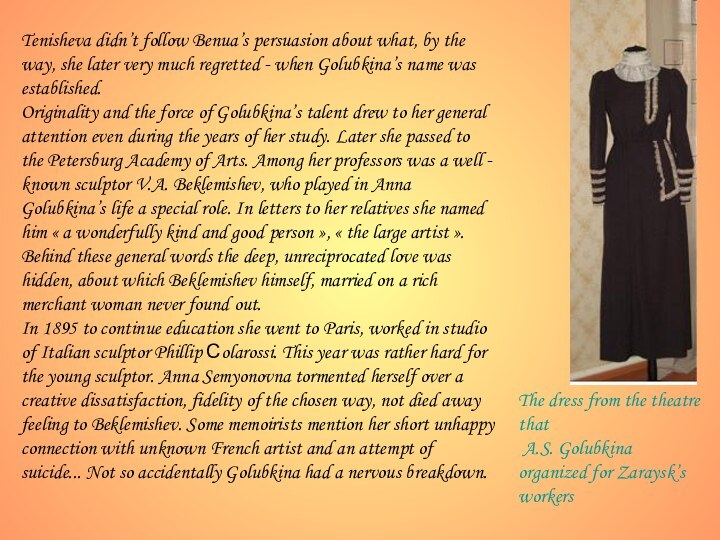
the way, she later very much regretted - when
Golubkina’s name was established.
Originality and the force of Golubkina’s talent drew to her general attention even during the years of her study. Later she passed to the Petersburg Academy of Arts. Among her professors was a well - known sculptor V.A. Beklemishev, who played in Anna Golubkina’s life a special role. In letters to her relatives she named him « a wonderfully kind and good person », « the large artist ». Behind these general words the deep, unreciprocated love was hidden, about which Beklemishev himself, married on a rich merchant woman never found out.
In 1895 to continue education she went to Paris, worked in studio of Italian sculptor Phillip Сolarossi. This year was rather hard for the young sculptor. Anna Semyonovna tormented herself over a creative dissatisfaction, fidelity of the chosen way, not died away feeling to Beklemishev. Some memoirists mention her short unhappy connection with unknown French artist and an attempt of suicide... Not so accidentally Golubkina had a nervous breakdown.
The dress from the theatre
that
A.S. Golubkina
organized for Zaraysk’s
workers
Слайд 18
Tenisheva didn’t follow Benua’s persuasion about what, by

the way, she later very much regretted - when
Golubkina’s name was established.
Originality and the force of Golubkina’s talent drew to her general attention even during the years of her study. Later she passed to the Petersburg Academy of Arts. Among her professors was a well - known sculptor V.A. Beklemishev, who played in Anna Golubkina’s life a special role. In letters to her relatives she named him « a wonderfully kind and good person », « the large artist ». Behind these general words the deep, unreciprocated love was hidden, about which Beklemishev himself, married on a rich merchant woman never found out.
In 1895 to continue education she went to Paris, worked in studio of Italian sculptor Phillip Сolarossi. This year was rather hard for the young sculptor. Anna Semyonovna tormented herself over a creative dissatisfaction, fidelity of the chosen way, not died away feeling to Beklemishev. Some memoirists mention her short unhappy connection with unknown French artist and an attempt of suicide... Not so accidentally Golubkina had a nervous breakdown.
Слайд 19
She was brought to Russia by a painter
E.S. Kruglikova. Having returned after a clinic to Zaraysk,
to her native family, Anna Semyonovna a little calmed down and began to think of how to live further. And eventually, decided to go with her elderly sister Aleksandra, who finished medical assistant's course, to Siberia. Here she worked helping her sister with who, as well as with her mother, had trusting relations. The sculpture’s mother Ekaterina Yakovlevna died at the end of 1898.
Anna Semyonovna could not come to her senses for a long period of time after this death and did not do any work, till she molded on memory her bust …
The second trip to Paris was more successful. Golubkina’s works were seen by the great Roden and he offered her to work under his supervision. A lot of years after, recollecting the year of work with the master, Anna Semyonovna wrote to him: « You gave me a chance to be free … ».
Слайд 20
''Sculptor E.D. Nikiforova-Kirpichnikova'', (1908)
The Russian Museum
Golubkina’s works
exposed in the Parisian Spring Salon in 1899, had
a deserved success.
Once again she visited Paris in 1902. She also visited London and Berlin, getting acquainted with universal masterpieces of art. She returned from the trip with huge duties; she had no money to rent a workshop and Anna Semyonovna never could obtain favorable orders.
To tell the truth, in the first years of the twentieth century some of works brought considerable profit to her. Golubkina’s sculptures more often appeared at the Russian exhibitions, each time getting enthusiastic reception. But all money that she earned Anna Semyonovna distributed to people in need, friends and to strangers with surprising generosity, endowed on a kindergarten, school, a folk theatre. She was unusually kind person …
Слайд 21
Having no family, Anna Semyonovna brought up her
niece Vera, the daughter of the elder brother. She
lived in Zaraysk at her relatives very often and for long periods of time.
In Golubkina’s house always gathered « politically unreliable people », expelled from the capitals, and local revolutionary intelligence.
Anna Semyonovna was arrested for distribution of leaflets. In September 1907 the court sentenced the sculpture to a year imprisonment in a fortress, but because of the state of her health she was released on the security. Anna remained very long time under the supervision of police.
Слайд 22
In 1920-1922-s Anna Semyonovna taught in art workshops,
but she had to leave from there because of
a bad atmosphere. She was about sixty, when to old illnesses from constant malnutrition and excitements the heavy stomach ulcer was added.
Anna Golubkina died September, 7, 1927 in native Zaraysk where she was buried …
Слайд 23
Conclusion.
The Sculptor
S. T. Konenkov
wrote after Golubkina’s
death
“ Anna Semyonovna
Golubkina did everything
for native
Russian Art.
Her life exemplified for
Soviet artists.
Only for artists?
Her life is a high moral
standard”.
Anna Semyonovna's life was difficult and hard, under all sorrows and rage, she saw a bright beam of hope, and decided to present it to people. She enclosed a drop of kind, unusually human soul into her works. In each work both pleasure and sorrow, happiness and gloom are felt of this nevertheless sometimes not easy life. And in every work we can see and understand the severity of reality …
Слайд 24
The Sculptor
S. T. Konenkov
wrote after Golubkina’s
death
“ Anna Semyonovna
Golubkina did everything
for native
Russian Art.
Her life exemplified for
Soviet artists.
Only for artists?
Her life is a high moral
standard”.
Слайд 25
Again and again in a museum I am-
In
severe magic land.
Admiring, worrying, brightening,
At each sculpture I stand.
Zaraysk- her childhood and youth,
Her inspiration spring,
Both will, and search, and thoughts,
And creative pleasure instant.
Zaraysk is paths in the field.
She made here a trace
Barefooted - not in red boots-
On dew cool land...
Я снова и снова в музее –
В суровом волшебном краю.
Любуюсь, волнуюсь, светлею,
У каждой скульптуры стою.
Зарайск. Ее детство и юность,
Ее вдохновенья родник,
И воля, и поиск, и думы,
И творческой радости миг.
Зарайск. Это – в поле дорожки.
Она проложила здесь след
Босая – не в красных сапожках –
По росной прохладной земле...
Today in Zaraysk there is Golubkina’s museum.
It is so popular, that people devote verses to it.
One of them is (Nikolai Dudin,
“In A. S. Golubkina’s Museum ”):








